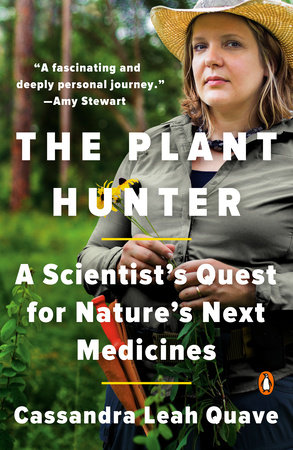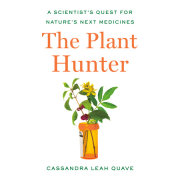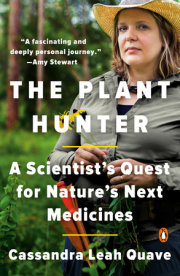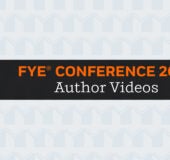Chapter 1
My Leg and the Wilderness
You only live twice:
Once when you are born
And once when you look death in the face.
Ian Fleming, You Only Live Twice, 1964
I'm descended from a long line of Quaves, running all the way back to Juan de Cuevas, born in Alg‡mitas, Spain, in 1762, who settled in what is now known as Harrison County, Mississippi. He married into the French Canadian Ladner family that had settled in the region, and they made their home on Cat Island, raising twelve children. To this day, their descendants carry a number of similar surnames-Cuevas, Coueves, Quave, and Queve. The name on my line of the family is pronounced kwave (rhymes with wave). We've always been people of the land.
My father, Raymond, grew up on Quave Street in Biloxi, which, at one time, was entirely inhabited by close relatives. Daddy's father, J. L., was a stumper. Back in the 1920s, colossal longleaf pines (Pinus palustris, Pinaceae) throughout the south were clear-cut and used to build the homes and businesses of small towns that popped up along the coastline and interior of Florida. These evergreen trees sport the longest needlelike leaves of any pine in the world and proudly stand between eighty and one hundred feet tall. After trees were felled, the stumps stayed behind. J. L. and his sons used bulldozers to push the stumps out of the ground and then blew them up with dynamite, blasting them into small enough pieces for grinding at the stump mill. The Hercules Powder Company had such a mill located on the Peace River in DeSoto County, Florida. After being washed, the stumps were ground into chips and steamed to extract turpentine and other by-products like nitroglycerin and black powder.
Stumping was an essential part of clearing the land following the timber harvest and creation of arable land for agricultural use. It was not easy work. My uncle Tommy lost several fingers playing with a hammer and a dynamite blasting cap as a kid, and another close member of J. L.'s work crew, Bo, died when a chain carrying heavy equipment broke and crushed him in the semitruck cab. Daddy grew up working outdoors, welding together pieces of scrap metal both as an artistic outlet and as a means to repair pieces of the business's bulldozers, tractors, and excavators. After the family moved from Mississippi to Florida, Daddy and his brothers became well known for their wild days of drag racing cars and trying to outrun the police. One of my uncles even served on a chain gang after being caught by a policeman.
At the age of twenty in 1969, Daddy made his first trip overseas, trading the swamplands of Florida for those of Vietnam. He served in the First Infantry, Eleventh Brigade, Company B, Third Battalion, Americal Division, Central Highlands. He trekked through miles of jungle recently defoliated by dioxin, or Agent Orange-a powerful herbicide sprayed by US military forces to eliminate forest cover and crops of the North Vietnamese and Vietcong troops. In late July 1970, his machine gun locked and loaded, he was on top of an armored personnel carrier (APC) with four other friends in his squad, their eyes on alert as they surveyed the horizon, sweat dripping down their backs. Six other members of his platoon rode inside the APC. They were positioned in North Vietnam, north of the Quaúng Ng‹i Province, with orders to move to another region where the Vietcong had been spotted. It happened fast. The startling sounds hit before the explosion could even register in Daddy's mind. The road they were traveling on had been rigged with booby traps-land mines hidden beneath the deceivingly plain soil.
Only he and the other four who rode on top of the APC survived. A chopper arrived quickly enough to medevac them to a military evacuation hospital in My Khe, a beach city in South Vietnam known as China Beach. Daddy didn't lose any limbs, but he suffered from back pain for the rest of his life where his vertebrae had been impacted. He received a Purple Heart for his service and was shipped back home. It was there in Arcadia, Florida, that he met my mother, Cissy. At the time Raymond had been in Vietnam, Cissy was attending Samford University in Birmingham, Alabama, first training in the field of biology and medical technology. While spending a summer interning at G. Pierce Woods, a medical facility for mentally disabled and psychologically ill persons in Arcadia, she and Daddy started dating. Tall and beautiful, with a youthful face and long straight chestnut hair that reached her waist, she was quite a catch.
My parents decided to start a family in that small town of Arcadia, located in southwest Florida in DeSoto County-about an hour's drive inland from the better-known coastal towns of Sarasota and Fort Myers. Daddy, like his father before him, worked in the stumping business, later expanding his work to larger-scale land-clearing operations in support of the booming agricultural industry (beef and dairy cattle, orange groves, and farms for tomatoes, strawberries, and watermelons). Momma worked in the school system as a special education teacher. They were happy and healthy and in love.
And then I came along.
I was born with the lower portion of my right leg underdeveloped, the foot bent in a strange angle at the ankle, the tibia above it short, and the fibula totally missing. Anklebones were missing, too. Imagine two legs, but one substantially shorter than the other, with the bottom of thzot only reaching the calf muscle of the longer leg. The doctors were baffled: there had been no indication of my birth defects during my motherÕs pregnancy. But this was 1978, a time before ultrasounds were a normal part of pregnancy checkups. My first few months of life were a constant series of visits to various doctors, putting a strain on not only my parentsÕ emotional well-being but also their finances.
As I grew, doctors explained to my mother that the pseudarthrosis (false joint) in my ankle combined with the growing limb-length disparity would make walking a serious challenge. Even if I wore braces to give my leg support, my pseudarthrosis would put me at risk of frequent fractures in my foot. To make matters worse, one medical resident predicted that in addition to my physical disabilities, there was a very high likelihood I'd also suffer from severe mental impairment, common in children with constellations of developmental defects-this was the one prediction that didn't materialize even as the others did. In short, they learned that a lifetime of risk, relative immobility, and imminent pain was what awaited me. My parents were crushed.
By the time I turned three, they needed to make a choice. After reviewing the stacks of medical records and considering the doctors' recommendations, my parents decided the best path forward was below-the-knee amputation: this would make walking easier for me with the use of a prosthetic leg. It wasn't an easy decision; even as they weighed the pros and cons of the choice, family members accused them of planning to mutilate their child. Tensions ran high.
By August of 1981, just two months after my third birthday, a surgical team successfully removed part of my leg. I was left with a nice residual limb below the knee complete with a thick pad of fatty tissue beneath the bone to fit into the socket of a prosthetic leg. After almost two weeks in the hospital, I was ready to go home. Everything went perfectly.
Three days later, back at home, Momma smelled something rancid. It wasn't coming from the compost or the trash can; it was coming from me, from my stump. The discharge nurse had said not to remove the bandages under any circumstances, but something deep inside of Momma told her there was a serious problem. The smell reminded her of infected wounds of sick horses from her youth, and so she began the slow process of unraveling the long spool of outer Ace bandages, as if she were unraveling a mummy from its protective covering. Very gently, she peeled off the next layer of thick cotton padding, when liquid started to drip out, thick and yellow like a snotty vanilla pudding. After lifting a stack of white nonstick bandages, the last barrier to the stump, she gasped as she watched a puddle of thick fluid, bits of fat and rotted tissue from the bottom of my calf muscle, fall to the floor. A long piece of white bone jutted out from the mess. Her instincts had been correct: my limb was rotting due to an infection. She rushed me back to the hospital.
'Noooooo!' I screamed, naked and squirming in the grasp of Momma's arms as a nurse assisted. 'Dont put me in the blood!' I sobbed, plump tears rolling down my reddened, puffy face.
We were in the whirlpool facility at Sarasota Memorial Hospital, and this was the first of many sessions of whirlpool therapy that I would have to undergo to treat my infected leg. It followed the debridement of my stump-a process by which the doctor had scraped the rotting flesh away. The drab room featured a floor of gray tiles punctuated by a few circular tubs on raised platforms. The smell reminded me of the operating room I'd been wheeled into weeks earlier, caustic and heavy in the air, making me cough between my sobs. Each tub was filled with Betadine solution-blood red in color-and bubbling from the jets that spun the solution around. To three-year-old me, they were putting me in a literal bloodbath.
Eventually, Momma won the battle of wills, as she often did, and I sat in the tub sobbing during the treatment. It wasn't painful-I was just convinced it was a vat of blood. An old lady who was also in the whirlpool center for therapy brought me a big yellow ducky the next day, and that eased the way for my future treatments over the next few weeks. Now it was just me and ducky in the bloodbath together.
Had it not been for Momma's foresight-indeed, if she had heeded the nurse's warning and not unwrapped the bandage when she did-I would have died. The infection had already ravaged my skin and soft tissues. I not only had gangrene but also a staph infection that had begun to enter the bone, forming a recalcitrant biofilm in the tissue-a disease known as osteomyelitis. I was hours away from the infection spreading to my bloodstream and then leading to sepsis and multi-organ failure.
Knowing what I do now about staph infections, I thank my lucky stars that it was a 1980s strain of Staphylococcus aureus, and not yet a multidrug-resistant HA-MRSA (healthcare-associated methicillin-resistant Staphylococcus aureus) prevalent in the nineties-and certainly not one of the horrifyingly aggressive CA-MRSA (community-associated MRSA) isolates that came soon after. Staph is devilishly cunning not only at spreading throughout the body, but also at forming a plethora of different types of infections in the bone (osteomyelitis), heart (endocarditis), bloodstream (bacteremia and sepsis), brain (abscess), and skin (soft tissue infections, even necrotizing fasciitis, or "zombie skin").
After three weeks in the hospital, I was sent home, again wrapped in padded stacks of bandages, and my parents watched closely for any other signs of infection. By mid-November, I was back in the hospital for another surgery. They needed to clip the bone back and stitch what was left of my flesh around it to create a stump that I could eventually walk on. As with the prior surgery and every surgery that was to come thereafter-there was fear, risk of death, and always the pain. But for now, I was in the clear. At the age of three, I had looked death in the face. There was more for me to do with this life. I was not ready to go yet. You only live twice.
Even with my disability, I loved playing outdoors, whether exploring dense oak hammocks or the piney woods and palm thickets near our house with my dog, Spot, or playing with my younger sister, Beth, on a massive mountain of dirt Daddy had built in the backyard. But it was looking through a microscope that transported me from the macroscopic world of watching insects march around the forest floor, or observing deer sniff out a grassy meal in the field, to somewhere altogether new and magical. To see something move under that microscope was to enter another dimension, a world I never knew existed, one just waiting for me to explore. This was when I truly fell in love with science and found an outlet for all the pent-up energy that seemed thwarted by my disability.
In third grade in 1987, I participated in my first science fair. My question was simple: What lives in a drop of pond water? Momma borrowed a microscope from the high school for me to use at home for the project. Collecting the samples had been challenging on crutches, but Spot and I had made it out to the front pond and back with a plastic cup full of pond water in hand. My goal was to look at multiple samples of water droplets, draw and identify the creatures I saw, and count how many of each could be found. Simple, elegant, and very exciting to me.
Underneath that microscope, I discovered that pond water teems with life. Translucent bodies twisted and swirled beneath the bright light. I bent over the microscope for an even closer look, knocking a pair of crutches that had been leaning on the kitchen table onto the tiled floor. I couldn't be bothered to pick them up. This was too important. I twisted the knob to click a higher-resolution lens into place, fine-tuning my view with the knob in my other hand.
"It's covered in hair!" I shouted.
No one was there to hear me.
The paramecium swam around inside the drop of pond water, its elongated oval body surrounded by short little hairs: they wiggled to propel it into motion. I picked up my colored pencils to draw it in my notebook before turning my attention to another creature floating about under the microscope's lens. This one was not in any single particular shape, but ambiguous, shifting to form armlike projections as it slid from one side of the viewfinder to the other. I flipped the pages in my encyclopedia.
"Aha!" I said. "You must be an amoeba!"
I jotted this down in my notebook and patiently drew its globular-like shape on the page. Daddy came in through the back door to the kitchen, knocking the dirt off his boots on the outside steps, returning from work on his heavy equipment out at the barn.
Copyright © 2021 by Cassandra Leah Quave. All rights reserved. No part of this excerpt may be reproduced or reprinted without permission in writing from the publisher.












